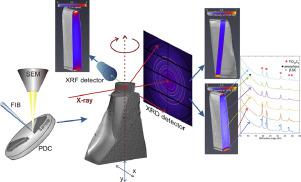当前位置:
X-MOL 学术
›
Acta Mater.
›
论文详情
Our official English website, www.x-mol.net, welcomes your
feedback! (Note: you will need to create a separate account there.)
Cracks, porosity and microstructure of Ti modified polymer-derived SiOC revealed by absorption-, XRD- and XRF-contrast 2D and 3D imaging
Acta Materialia ( IF 8.3 ) Pub Date : 2020-10-01 , DOI: 10.1016/j.actamat.2020.07.067 Małgorzata Makowska , Pradeep Vallachira Warriam Sasikumar , Lorenz Hagelüken , Dario F. Sanchez , Nicola Casati , Federica Marone , Gurdial Blugan , Jürgen Brugger , Helena Van Swygenhoven
Acta Materialia ( IF 8.3 ) Pub Date : 2020-10-01 , DOI: 10.1016/j.actamat.2020.07.067 Małgorzata Makowska , Pradeep Vallachira Warriam Sasikumar , Lorenz Hagelüken , Dario F. Sanchez , Nicola Casati , Federica Marone , Gurdial Blugan , Jürgen Brugger , Helena Van Swygenhoven

|
Abstract Morphology, phase composition, cracks and porosity are investigated in monolithic Ti modified SiOC polymer-derived ceramics pyrolyzed at 1000 °C and 1400 °C using synchrotron X-ray full field absorption-contrast tomographic microscopy and scanning XRF- and XRD-contrast microscopy. Samples pyrolyzed at 1000 °C show a crack-free structure, but pyrolysis at 1400 °C results in formation of cracks and at higher Ti content also shows porosity. Tomography revealed the formation of a layered morphology that varies in terms of crystallographic structure and/or Ti stoichiometric concentration. The microstructural observations and electrical conductivity are discussed in terms of pyrolysis temperature and Ti content.
中文翻译:

通过吸收、XRD 和 XRF 对比 2D 和 3D 成像揭示 Ti 改性聚合物衍生的 SiOC 的裂纹、孔隙率和微观结构
摘要 使用同步加速器 X 射线全场吸收对比断层显微术和扫描 XRF 和 XRD 对比显微术研究了在 1000 °C 和 1400 °C 下热解的整体 Ti 改性 SiOC 聚合物衍生陶瓷的形貌、相组成、裂纹和孔隙率. 在 1000 °C 下热解的样品显示出无裂纹结构,但在 1400 °C 下热解会导致形成裂纹,并且在较高的 Ti 含量下也显示出孔隙率。断层扫描揭示了分层形态的形成,其在晶体结构和/或 Ti 化学计量浓度方面有所不同。根据热解温度和 Ti 含量讨论了微观结构观察和电导率。
更新日期:2020-10-01
中文翻译:

通过吸收、XRD 和 XRF 对比 2D 和 3D 成像揭示 Ti 改性聚合物衍生的 SiOC 的裂纹、孔隙率和微观结构
摘要 使用同步加速器 X 射线全场吸收对比断层显微术和扫描 XRF 和 XRD 对比显微术研究了在 1000 °C 和 1400 °C 下热解的整体 Ti 改性 SiOC 聚合物衍生陶瓷的形貌、相组成、裂纹和孔隙率. 在 1000 °C 下热解的样品显示出无裂纹结构,但在 1400 °C 下热解会导致形成裂纹,并且在较高的 Ti 含量下也显示出孔隙率。断层扫描揭示了分层形态的形成,其在晶体结构和/或 Ti 化学计量浓度方面有所不同。根据热解温度和 Ti 含量讨论了微观结构观察和电导率。











































 京公网安备 11010802027423号
京公网安备 11010802027423号